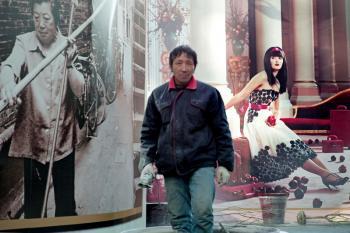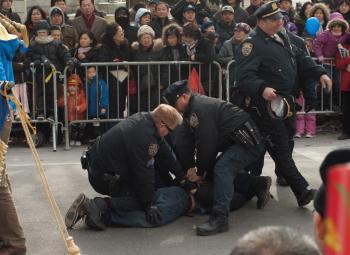A disaster in the southern Chinese city of Nanjing in which scores if not hundreds of people died has become an occasion for China’s state-run media to try to discredit The Epoch Times. At issue is a photo mistakenly said to be of the Nanjing disaster that this newspaper’s Chinese edition published on its website.
“Xinhua and other state-run media wish to deceive the Chinese people in two ways in reporting on this photo,” said Pan Hongyi, deputy editor-in-chief of The Epoch Times.
“They want to divert attention from the large loss of life and the failure of the authorities to take responsibility for the disaster in Nanjing, while at the same time leading the Chinese people to distrust The Epoch Times. In fact, the photo was planted by the Chinese regime for this purpose,” Mr. Pan said.
On July 28, Epoch Times reporter Fang Xiao filed a story about a major explosion that had shaken a densely populated area of Nanjing. Fang’s report noted the discrepancy between the official death toll and that provided by several eyewitnesses and initial media reports.
Officials reported a death toll of 13, while the other sources gave estimates of between 79 and hundreds.
Published with Fang’s story was a photo that showed dozens of badly burned bodies.
The photo turned out to be a cropped photo of a disaster in Africa, not Nanjing. The uncropped photo was clearly not a scene from China: It shows a group of black Africans looking at burned bodies.
“We investigated the photo of the burned bodies and found that a Chinese Communist Party (CCP) agent cropped a picture from an oil tanker explosion incident in Africa, leaving only the dead bodies in the picture,” Mr. Pan said.
“The photo was sent to a netizen by the agent, who claimed it was from a worker at the explosion site. That netizen has been providing information to The Epoch Times for a few years and has been a trusted source. The netizen believed it came from the scene in Nanjing and passed it to The Epoch Times reporter, saying it was a photo from the explosion site,” he said.
“We found out the problem with the picture on July 29, removed the picture immediately, and informed other media outlets about the mistake,” Mr. Pan said.
CONTINUED on Page 2...
State-Run Media Accuse
Chinese state media soon reported that The Epoch Times had deliberately used a fake photo of the incident.
The first to report, on Aug. 3, was Kai Feng Web, a website closely affiliated with the CCP that carries among the most vituperative slanders against Beijing’s enemies, particularly the spiritual practice Falun Gong. Kai Feng showed both the cropped and uncropped versions of the photo side by side, with the cropped photo having the Epoch Times watermark.
In what appeared to be an organized campaign, Xinhua, major state-run media, and Internet forums quickly picked up the story, in both Chinese and English. They claimed that The Epoch Times had intentionally published a fake photo in its reporting on the explosion in Nanjing.
Controlling the Message
Immediately after the Nanjing explosion, Party propagandists began controlling the news about the scope of the disaster, the death toll, and who would report on it; they shut down alternate voices and promoted the version of events as told by Xinhua, the official mouthpiece of the Communist Party.
A broadcast journalist from a Jiangsu TV station was interrupted while reporting live, as Ye Hao of the Nanjing Municipal Propaganda Department demanded “Who let you broadcast live?” before driving the TV journalist away. The conversation between the official and the reporter was itself broadcast live and the clip uploaded to the Internet.
The Yangtse Evening Post, a popular newspaper in Nanjing, was forced to cut nine pages of coverage of the explosion. Staff later micro-blogged: “We are sad, frustrated, and in pain!” in response to the censorship.
The exception to the silence among local media was Modern Express, which ran the news on its front page, with the death toll of 13. Modern Express is run by the Xinhua News Agency’s Jiangsu branch.
The Epoch Times seeks to avoid the state’s efforts at controlling the media by getting news directly by calling residents and tapping into its network of contacts.
Manipulating the News
In the Chinese media, tricks such as the planting of the photo of the burned bodies are not unprecedented. After the Tiananmen Square massacre on June 4, 1989, a CCP agent released news saying that Li Peng, the then-premier, had been shot. The Hong Kong-based newspaper Mingpao and other media carried this as a lead story.
Later, Li appeared in public, disproving the rumor. This episode created doubts in the minds of readers as to what had really happened and helped in the regime’s efforts to cover up the massacre for Chinese readers.
The use of agents to manipulate the news has become an important part of the Chinese regime’s strategy for controlling the Internet.
CONTINUED on Page 3...
[xtypo_dropcap]T[/xtypo_dropcap]he media environment in China has changed, with information getting out that the authorities cannot completely control. There are large numbers of protests and conflicts with authorities over disasters, like the Nanjing explosion, in which the authorities likely share responsibility.
Chinese citizens as netizens have tried to use the Internet to provide the facts about the events happening in China and are often relied on to pass on information from the scene.
The Chinese regime has adjusted to the independent reporting of facts through the Internet by hiring and training a large number of Internet secret agents who generate phony news and pictures online. The job of these agents is to deceive the public, making them believe they are getting independent news about events when in fact they are being given the Party’s line. Failing that, the agents’ fake reports often have the effect of leading readers not to believe any news reporting, which also serves the Party’s purposes.
Targeting The Epoch Times
The targeting of The Epoch Times for its reporting on the Nanjing disaster is part of a 10-year-old effort by the CCP.
The Chinese regime has sought to suppress The Epoch Times since it first began printing. In November 2000, just a few months after The Epoch Times first began, 30 Epoch Times staff members inside mainland China were arrested, with at least one dozen reporters sentenced to 3 to 10 years in prison, some of whom were subjected to severe torture.
More recently, Epoch Times columnists have been arrested: Zheng Yichun in 2004, Zhang Lin in 2005, and Zhang Jianhong (pen name Li Hong) in 2007.
“Outside of China, The Epoch Times has faced persistent attempts by the Chinese regime to interfere with our operations,” said Mr. Pan. “In spite of the attempts to silence The Epoch Times, we have continued to report the facts to the Chinese people, which has frightened the regime.”
“In this case, The Epoch Times reported accurately on the loss of life in Nanjing. The important story here is not a mistake made with a photo; it is the lies by the Chinese regime about what happened in Nanjing and then the lies told to try to distract from the original lies,” Mr. Pan said.
“We want to thank the people in China who have provided truthful news and information despite the dangers involved,” he said.
Read the original Chinese article.


